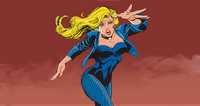 Dinah Laurel Lance, Black Canary 2First appearance:
Dinah Laurel Lance, Black Canary 2First appearance: since this is the daughter of the first one we’re talking about, her first appearance, retroactively speaking, was in
Justice League of America #75 in late 1969, but it was only in
Justice League of America #219-220 in 1983 that this actually became known officially, when Johnny Thunder’s Bahdnesian genie, Thunderbolt, explained how, thanks to a spell cast upon her in childhood by the Wizard, she’d gained her Canary Cry, but because at that time it was thought to be a curse, parents Dinah Drake and Larry Lance and also Johnny himself decided that she’d have to be put in comatose protection, which T-Bolt did by storing her inside his own magical realm, bringing her out when her mother died off-panel following the battle with Aquarius in
JlofA #73-74, and turning what might’ve been a curse into a blessing. And then, in 1986, Roy Thomas, the writer who’d come up with the whole retcon idea in the first place, revised it again in
Secret Origins so that it was told that she’d grown up normally, taking up the Canary mantle at age 19, and that her Canary Cry was the result of exposure to some of the first Green Lantern’s energies, and became fully manifested as she grew older.
Current status: continuing in her career as a crimefighter, getting her missions mostly from the former Batgirl Barbara Gordon, now Oracle.
Was subjected to the following acts of discrimination: the Blonde Bombshell had been underused many times before, and even subjected to at least one really stupid storyline in an issue of
The Brave and the Bold in 1981. In
Green Arrow: The Longbow Hunters in 1987, she was captured and tortured by a drug baron, whom Green Arrow shot to death, but not before the scumbag’s violence deprived Dinah of her ability to have children, and also of her Canary Cry. But the real bottom-feeder discriminatory act to have been inflicted upon Dinah was in Identity Crisis #3, when Deathstroke, in a more or less out-of-character appearance, tried to strangle and handcuff her in a contrived fight scene.
What’s wrong with how this was done? Anyone could argue, not without justification, that what she went through in The Longbow Hunters was more gruesome than need be (as far as I know, it was said that she hadn’t been raped by the drug baron, yet that itself still doesn’t make the story any good, nor does it justify its existence). But what she went through in Identity Crisis at the hands of Deathstroke, that was crude, vulgar, obscene, to say nothing short of juvenile and imbecile. And those reviewers who fawned over the miniseries have the chutzpah to say that this is storytelling at its most masterful? Puh-leez.
Was there anything good to come out of this? Out of
The Longbow Hunters, yes, but out of Identity Crisis,
NO. Following
The Longbow Hunters, when Green Arrow got his own series, and Dinah was a frequent co-star, she developed surprisingly well as a character, even getting her own mini-feature in
Action Comics Weekly written by Sharon Wright, who’d also assisted Mike Grell in writing her parts in
Green Arrow's own series. In 2001, two years after
Birds of Prey began as an ongoing series, Chuck Dixon wrote an adventure for Dinah in which she tripped to one of the Lazarus Pits Batman’s adversary Ra’s al Ghul used to revitalize himself, and this restored Dinah’s Canary Cry and ability to have children. With that in mind, what else can I say, but, bravo, Dixon!
 Tula, Aquagirl
Tula, Aquagirl




